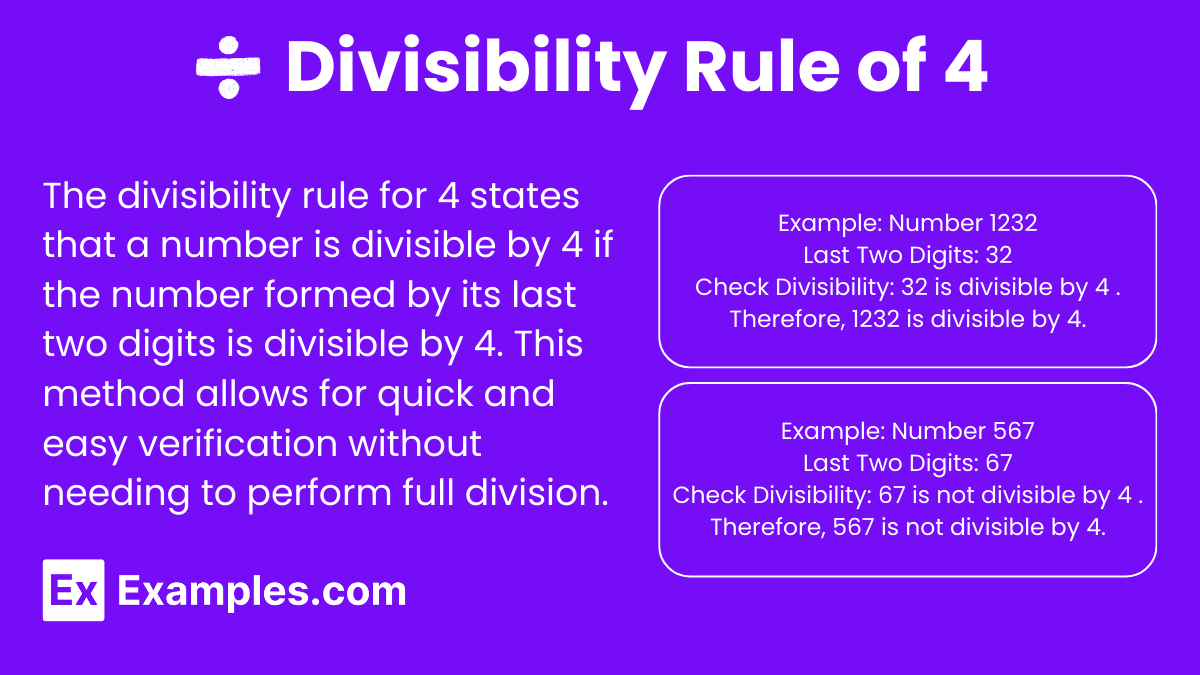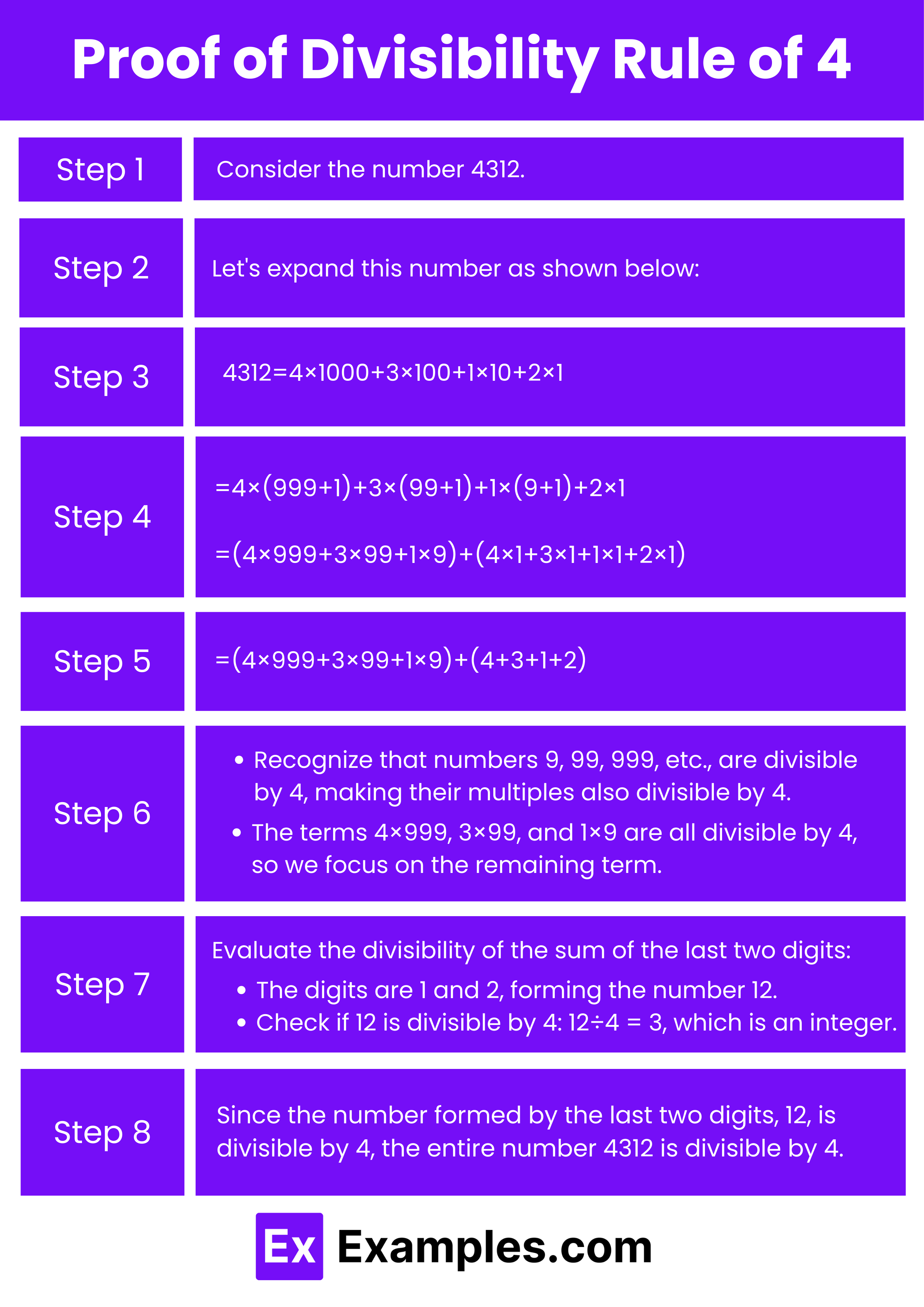Which of the following numbers is divisible by 4?
1236
1235
1234
1233


The divisibility rule for 4 provides a practical method to quickly determine if a number is divisible by 4, simply by checking if the number formed by its last two digits is divisible by 4. This rule is pivotal in various branches of mathematics, including Algebra, where it aids in factorization and simplification tasks. It also plays a role in operations such as addition, subtraction, multiplication, and division, enhancing efficiency in handling both rational and irrational numbers as well as integers. Understanding and applying this rule is essential for mastering foundational arithmetic operations and advancing in mathematical studies.
Download Proof of Divisibility Rule of 4 in PDF

Download Proof of Divisibility Rule of 4 in PDF
Step 1: Consider the number 4312.
Step 2: Let’s expand this number as shown below:
Step 3: 4312=4×1000+3×100+1×10+2×1
Step 4: =4×(999+1)+3×(99+1)+1×(9+1)+2×1
=(4×999+3×99+1×9)+(4×1+3×1+1×1+2×1)
Step 5: =(4×999+3×99+1×9)+(4+3+1+2)
Step 6: Recognize that numbers 9, 99, 999, etc., are divisible by 4, making their multiples also divisible by 4.
The terms 4×999, 3×99, and 1×9 are all divisible by 4, so we focus on the remaining term.
Step 7: Evaluate the divisibility of the sum of the last two digits:
Step 8: Conclusion from the example:
The divisibility rule for 4 states that a number is divisible by 4 if the number formed by its last two digits is divisible by 4. This rule is quite straightforward and can be quickly applied:
The divisibility rule for 6 combines the rules for 2 and 3. A number is divisible by 6 if it is divisible by both 2 and 3. This means:
The divisibility test for 4 is based on the property of the last two digits of a number. A number is divisible by 4 if the last two digits form a number that is divisible by 4. This test is particularly useful because it eliminates the need to divide the entire number, making the process much quicker.
Look at the last two digits; 24 is divisible by 4, so 1024 is also divisible by 4.
Yes, the divisibility rule of 4 can be applied to any number, no matter how many digits it has, as long as you can check the last two digits.
The last two digits are 56, which is divisible by 4, so yes, 123456 is divisible by 4.
Yes, any number whose last two digits are 0 is divisible by 4, as 0 represents zero, which is divisible by any non-zero integer.
In base 10, each power of 10 increases by one zero, making any number divisible by 100 automatically divisible by 4. Thus, only the last two digits affect divisibility by 4.
Yes, the divisibility rule for 4 applies to negative numbers as well. Just consider the absolute value of the last two digits.
Consider the number 718. The last two digits are 18, which is not divisible by 4, so 718 is not divisible by 4.
Yes, if the last two digits of a number are 12, the number is divisible by 4 because 12 ÷ 4 = 3 with no remainder.
This rule simplifies the task of finding factors and multiples, aids in reducing fractions, and can be useful in practical scenarios like dividing items into groups or calculating perimeters in units divisible by four.
Text prompt
Add Tone
10 Examples of Public speaking
20 Examples of Gas lighting
Which of the following numbers is divisible by 4?
1236
1235
1234
1233
Which number is not divisible by 4?
752
848
940
925
If a number ends in 48, what can you say about its divisibility by 4?
It is divisible by 4
It is not divisible by 4
It is divisible by 2 only
It is divisible by 8
Which of the following numbers is divisible by 4?
1089
1296
3456
7890
Determine if the number 876 is divisible by 4.
Yes
No
Only divisible by 2
Only divisible by 8
If a number ends with 92, is it divisible by 4?
Yes
No
Only divisible by 2
Only divisible by 8
What is the rule for determining if a number is divisible by 4?
The number must be even
The last two digits must be divisible by 4
The number must end in 0
The sum of the digits must be divisible by 4
Which of these numbers is not divisible by 4?
1400
1600
1700
1800
Is 256 divisible by 4?
Yes
No
Only divisible by 2
Only divisible by 8
Which number among the following is divisible by 4?
5678
6789
7896
8901
Before you leave, take our quick quiz to enhance your learning!

